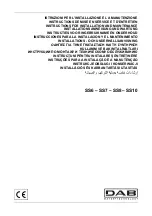
ENGLISH
22
The following cases are possible:
Same pressure, same AMPS obsorbed:
–
If the gauge readings do not differ substantially
from previous readings, the impellers are not worn
and motor rotation is correct.
–
If the AMPS absorber did not change from the
original readings, the pump and motor internal
rubbing did not increase and the percentage of
water suspended sand is not representing a
problem for the pump.
Lower pressure:
–
Lower pressure means worn impellers, or too low
main voltage.
Higher AMPS absorbed:
–
This usually indicates a strong rubbing by the
bearing journals due to suspended solids.
SECOND TEST
–
Open completely the gate valve.
–
Note the AMPS absorbed.
–
Note pressure as reported by the pressure gauge.
–
Note pump delivery as reported by the flow meter.
The following case is possible:
–
Pump delivery lower than rated delivery. This can
depend from scaling, from a clogged upstream
valve or from leaks along the pipe line.
8. MAINTENANCE
–
Periodical maintenance is strictly related to the
percentage of water suspended sand.
–
No maintenance is necessary as long as the
pump keeps running efficiently, i.e. pump delivery
keeps above 50% of rated delivery or the AMPS
absorbed do not exceeds the 5% allowance.
–
In some cases it will be necessary to replace worn
parts such as impellers, sealing rings or bearings.
–
In case of an high sand percentage, we suggest a
first inspection after a 1000 running hours.
–
During long idle periods in the well, the pump /
motor groups should be shortly started every 2 or
3 months.
–
Making sure the group is still fully submersed.
9. REPAIRING THE PUMP
9.1 Disassembling the pump / motor group
Because of its construction features, the pump and
motor group easily disassembled and re-assembled
with normal metric size shop tools.
–
If the pump adopts a non return valve, consider the
additional weight of the water-filled column besides
the group weight and use therefore a suited hoist.
–
We suggest to employ specialized personnel for
assembling and disassembling.
9.2 Assembling the pump / motor group
–
Check the free rotation of pump and motor rotating
parts, paying attention not to damage them.
–
The axial joint between pump shaft and motor shaft
should be installed without forcing. Absolutely avoid
kicking the shaft, as that could damage the thrust
bearing.
–
The pump-motor coupling should be done perfectly,
a wrong alignment will unavoidably cause motor
bearing failure and vibrations.
–
The pump joints are provided with screws to lock
the rotating part axially.
The coupling screw for 10" - 12" - 14" motors should
be strongly locked on the motor key.
–
When coupling 6" - 8" motors, the coupling screw
shall be aligned to the hole located on the motor
shaft; after locking, the screw must be unscrewed
half turn and locked in this position by a sealing
product (loctite or similar) or in a mechanical
position positive way (calking), paying attention not
to damage the screw thread. The locking of the
screw on the shaft could cause an eccentrical
rotation of the rotating part and consequently
damage the bearings.
10. DECOMMISSIONING AND
DISMANTLEMENT
When the pump will be permanently stopped and
dismantled, the various materials composing it should
be properly disposed of. It is important to make sure that
no residual polluting liquids are trapped within the pump.
The materials used in pump construction are:
-
Steel and cast iron.
-
Aluminum.
-
Rubber and plastic.
-
Copper.
The disposal of polluting liquids and materials should
follow current environmental regulations.



























